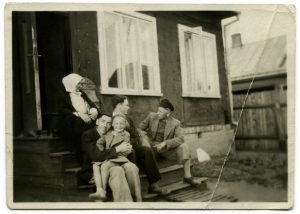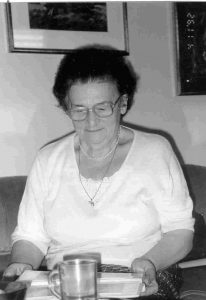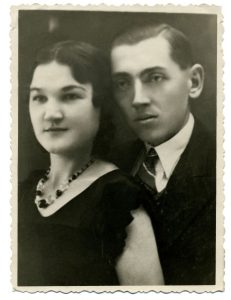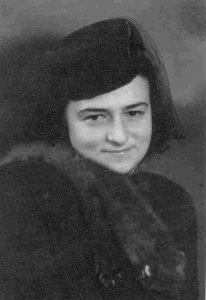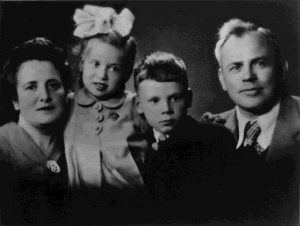Balys Simanavicius and Artūras Esertas
Excerpt from Balys Simanavičius' Diary
The Nazis ordered to kill all children under twelve years of age, as well as old people who were unable to work. A woman whose name was Pomerancienė worked for me. Her husband was a violinist with the Kaunas theatre, who knew Kipras Petrauskas. I did not know how his wife, who worked for me, got in touch by phone with Petrauskienė and agreed that she would take his daughter. Petrauskienė agreed to take her in, but the question was how to take her there. While still in the ghetto, the girl was given a sleeping pill, and still sleeping, she was taken to the factory to an old woman. It was a Saturday and I was asked to take her to the Petrauskas’ family, but at that moment, I was unable to do it, as I had to go to Kudirkos Naumiestis to bring hides. I left Saturday in the evening and returned early in the next morning, sleepless and hungry. I changed quickly, and the old woman and I went in a cart to “baptise” the girl, who had spent the night with her. In the yard, there were some policemen, one of them was Lithuanian, the other was German. The latter used to check those who had little children with them.
At that time, Kipras Petrauskas lived on Laisvės alėja, and I had to take the girl along present Požėlos Street, which led straight to Laisvės alėja. However, on the corner of the intersection of Laisvės alėja and Raudonosios armijos prospektas some policemen were standing. They stopped me and asked me where I was going. Fortunately, I knew one of the policemen. I said that I was taking the girl to the Cathedral to be baptised. They believed me, besides, I had German documents. We went round the Town Hall and finally reached the Petrauskas’ house driving along the embankment of the Nemunas.
I took the girl into my arms and ran into the hall. I climbed to the first floor, rang the bell and waited. I had to wait long or perhaps it only seemed to me so. Waiting, I looked at the girl, she was looking at me and kept silent; she seemed as though asking me to save her, and I was so sorry for her. And I thought that if Petrauskienė did not take her in, I would not abandon her. At that moment, the door opened and Petrauskienė appeared. I told her: “I have brought you a present.” She only asked what her name was. I did not know, and had the idea to name her Dana, and she remained Dana. Such is Dana Pomerancaitė’s story. Later she graduated from the Vilnius Conservatoire, took a postgraduate course in Moscow, and worked as a teacher at the Kiev Conservatoire. She married the violinist Mazurkevičius. She and her family have left the Soviet Union, and I have heard from reliable sources that she lives in Canada.
Feiga Aleksanderytė-Koganskienė about Balys Simanavičius and Artūras Esertas, the Rescuers of the Prisoners of the Kaunas Ghetto
In the spring of 1943, I lived in the Kaunas Ghetto. My rescuer, my sister’s husband German Artūras Esertas was an assistant director at the tannery “Lapė”, while Balys Simanavičius was the director. In order to keep in touch with the relatives and acquaintances in the ghetto, Esertas and Simanavičius took out a permit for a brigade of ghetto prisoners to work at the factory as tanners. Every day, this brigade accompanied by guards was taken to work and back to the ghetto. My brother Mordechajus Aleksanderis was a member of the brigade. Several times, I was also taken from the ghetto to the factory as an auxiliary worker. It was then that I met Balys Simanavičius.
At that time, Esertas and Simanavičius were looking for a hideout for the people taken out of the ghetto. Simanavičius took me to a place in Romainiai, which had been offered by an intermediary. The place had not been fixed up, it was not safe, and therefore I could not stay there. However, I did not return to the ghetto, but went to Artūras Esertas.
Simanavičius and Esertas equipped a hiding place in the attic of the factory. Eighteen people, my brother and his family among them, found shelter there. The rescuers saw to it that the living conditions in the hideout were as good as possible. An old factory worker brought us foodstuffs early in the morning and took out the rubbish. The people could cook hot meals, wash, and wash clothes.
As the frontline was approaching, they knew that the retreating Germans would explode the industrial buildings and their hideout would not last long.
One day, people from the city administration called Esertas at the factory and ordered him to take all the Jews working there back to the ghetto, as the brigade was being disbanded and would not be taken to the factory again. Esertas learned that the liquidation of the Kaunas Ghetto had started and advised the workers not to return to the ghetto and go wherever they could. However, Špegelis, who was the Jewish brigade leader refused flatly and forbid them to leave the factory.
Shortly after, a group of soldiers arrived at the factory. The people realised what that meant. They panicked and started running around. The worker Gordonas, looking for a place to hide, rushed to the staircase leading to the hideout in the attic. The guard noticed that and opened fire.
Hearing the shots, the people in the hideout rushed to the windows to see what was happening. The guards noticed them, turned them out of the hideout, half-naked, and drove them to the ghetto together with the workers’ brigade. Their fate did not differ from that of the other ghetto prisoners...
It is difficult to describe how Simanavičius and Esertas felt that day. They were faced with mortal danger. They knew that they would have to answer questions about who made the hideout, brought the people from the ghetto, who looked after them and so on.
As the frontline was quickly approaching Kaunas, Simanavičius and Esertas went into hiding for a short time and avoided retribution.
My brother and his family had left the hideout one day before it discovered and were saved.
From Rūta Lopianskaitė-Gorinienė's Memoirs
My mother’s sister Riva Pomerancienė, her husband Danielius Pomerancas, famous violinist of the pre-war Kaunas, and their one and a half years old daughter lived with us in the ghetto.
Like the rest of the ghetto prisoners, my mother was doing forced labour in the city. Each night upon returning to the ghetto she would be searched by the guards at the gates as the prisoners were not even allowed to bring bread for their families. The searches caused great suffering to her and her health declined because of constant stress.
Then, the ghetto prisoners found out about the upcoming roundup of children. Worried parents tried to save their children. Hideouts were built in basements and attics. My family decided to hide the three children – me and my mother’s cousin’s twins who were a bit older than me – in an oven. The interior of the oven was dismantled and all bricks were removed to make enough space for three children. On that horrible day, we were hidden in that oven.
The Germans came into the apartment and started throwing and breaking things with their batons. One of the twins sneezed and the Germans heard him. They opened the oven and pulled us out. I was very small but it must have been an important event for me as I remember everything very clearly. One of the Germans took the twins and their mother to the car and drove away. We later found out that the children were shot down. My mother picked me up and looked at me for a long time as if anticipating a disaster. Then she sat me on a polished brown table and started dressing me up very slowly. Later, a German soldier put me and my mother in a car and took us to some open field. He got out of the car and hinted us to run. My mother picked me up, got out of the car as fast as she could and this is how we escaped.
This was a very good sign to use this opportunity and save me and the rest of the children. People who had friends and acquaintances tried to smuggle the children out of the ghetto and hide them.
My mother had such an acquaintance too. Mr. Balys Simanavičius was the director of the Kaunas fur factory “Lapė”. My mother knew him before the war. One day, they agreed to get me out of the ghetto. Shortly I was drugged, put in a potato sack and smuggled out of the ghetto under an agreement with the gate guard.
Balys Simanavičius took me to the farmers living in a village near Kaunas. My mother managed to hide in Kaunas. Balys Simanavičius helped her find a hideout in the attic of one of the houses in Kaunas suburbs. She would spend long days and nights all by herself in that hideout.
When the Russians came back, Balys Simanavičiaus was exiled to Siberia despite all his good deeds. In 1953-54, he returned and we met multiple times. He told me a lot about my parents, the ghetto and my escape.
In a similar fashion, Danutė, daughter of my aunt Riva Pomerancienė, was also smuggled out of the ghetto with the help of Balys Simanavičius and taken to the family of the famous opera singer Kipras Petrauskas. The Petrauskas family knew Danielius Pomerancas, the famous violinist, and his family very well. Danielius Pomerancas himself was taken to the Dachau concentration camp by the Germans. The Petrauskas family risked their lives and the lives of their three children and took the year-and-a-half old Jewish girl, who was also brought to them drugged. The Petrauskas family was known to everybody in the city and obviously everyone knew that they had no little babies.
Mrs. Petrauskienė said she was waiting with fear for the girl to awake as she did not know what language she would speak. The name Danutė was given to her upon arrival in the new family.
Thus, me and my cousin found ourselves in new families

